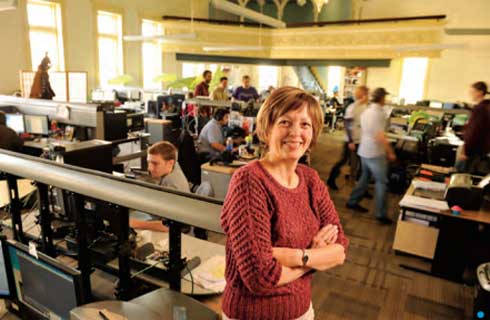Doctor of Philosophy in Materials Science and Engineering - Electronic Materials

学历文凭
Ph.D.

专业院系
材料科学

开学时间

课程时长

课程学费

国际学生入学条件
For admission to graduate study, an applicant must have a U.S. bachelor's degree or the equivalent of a U.S. bachelor's degree prior to enrollment.
Transcripts and Degrees must be in English (all post-secondary education, including transcript keys).
Unofficial transcripts should be uploaded to your graduate application. The minimum requirement for admission consideration is the completion and award of a four year U.S. bachelor's degree, or its equivalent, by the time of planned enrollment.
Personal Statement
Resume or curriculum vitae
Two letters of recommendation
Portfolio, if required by department
TOEFL score of 88 iBT
IELTS score of 6.5
Transcripts and Degrees must be in English (all post-secondary education, including transcript keys).
Unofficial transcripts should be uploaded to your graduate application. The minimum requirement for admission consideration is the completion and award of a four year U.S. bachelor's degree, or its equivalent, by the time of planned enrollment.
Personal Statement
Resume or curriculum vitae
Two letters of recommendation
Portfolio, if required by department
TOEFL score of 88 iBT
IELTS score of 6.5
IDP—雅思考试联合主办方

雅思考试总分
6.5
了解更多
- 雅思总分:6.5
- 托福网考总分:88
- 托福笔试总分:160
- 其他语言考试:Duolingo score of 120<br>PTE score of 59
CRICOS代码:
申请截止日期:请 与IDP联系 以获取详细信息。
课程简介
The next generation of devices for computing, communication, sensing and energy conversion demand new materials with novel electronic properties as well as techniques to synthesize these materials with high quality and control over defects. Electronic materials research at Rensselaer targets nanoscale interconnects, interfaces with designed electronic and thermal transport, new semiconductors, ferroelectrics, optical / plasmonic materials, 2D materials and materials for future quantum and neuromorphic computing architectures.<br><br>Electronic devices at nanoscale dimensions pose fundamental material property and processing challenges. Research at Rensselaer targets new metal interconnects for low-resistance charge transport in sub-10-nm wires, combining computational prediction of optimal materials with thin film and nanostructure growth techniques using both vapor/vacuum phase and electrochemical methods. Research in chemical mechanical planarization facilitates precise surface-flatness required for semiconductor interfaces, while molecularly-tailored interfaces enable control of interfacial thermal conductance, Fermi level pinning and charge transport.<br><br>The MSE faculty are also actively engaged in designing materials for new functionality in future electronic and photonic devices, with as yet unknown architectures. This involves the application of a wide range of tools spanning first-principles computational prediction of new materials, thin film deposition including epitaxial techniques and detailed characterization of crystal structure, nanoscale electronic and structural dynamics, and spectroscopy. These collaborative efforts target new oxides, nitrides, halide perovskite and low-dimensional materials for semiconducting, magnetic, thermoelectric, ferroelectric and plasmonic functionality. Computational and experimental research currently underway in the department specifically target material functionality for devices mimicking neurons in the brain for neuromorphic computers for efficient artificial intelligence, and quantum states of point defects as a platform for solid-state quantum computers.
相关申请

预科

奖学金

实习机会

在校学习

跨境学习

校园授课-线上开始

在线/远程学习
学校排名
世界排名
351
数据源:泰晤士高等教育世界大学排名
本校相关课程
电气工程学学士学位

学历文凭
Bachelor Degree
下一个开始日期
课程费用总额
Bachelor of Science in Interdisciplinary Science

学历文凭
Bachelor Degree
下一个开始日期
课程费用总额
Bachelor of Science in Physician-Scientist/Doctor of Medicine

学历文凭
Combined Bachelor's / Doctoral Degree
下一个开始日期
课程费用总额
技术商业化和创业学理学硕士

学历文凭
Masters Degree
下一个开始日期
课程费用总额
科学技术哲学博士

学历文凭
Ph.D.
下一个开始日期
课程费用总额
物理学哲学博士

学历文凭
Ph.D.
下一个开始日期
课程费用总额
其他相关课程
工程哲学博士-材料科学与工程(博士学位,可选)

麦克马斯特大学
泰晤士高等教育世界大学排名:

学历文凭
Ph.D.
下一个开始日期
课程费用总额
Master of Science in Materials Science

安大略理工大学
泰晤士高等教育世界大学排名:915

学历文凭
Masters Degree
下一个开始日期
课程费用总额
Master of Science in Materials Science and Engineering

克莱姆森大学
泰晤士高等教育世界大学排名:

学历文凭
Masters Degree
下一个开始日期
课程费用总额
材料科学哲学博士

南加州大学
泰晤士高等教育世界大学排名:74

学历文凭
Ph.D.
下一个开始日期
课程费用总额
材料科学理学硕士

南加州大学
泰晤士高等教育世界大学排名:74

学历文凭
Masters Degree
下一个开始日期
课程费用总额
Doctor of Philosophy in Materials Science and Engineering

北德克萨斯大学
泰晤士高等教育世界大学排名:

学历文凭
Ph.D.
下一个开始日期
课程费用总额




